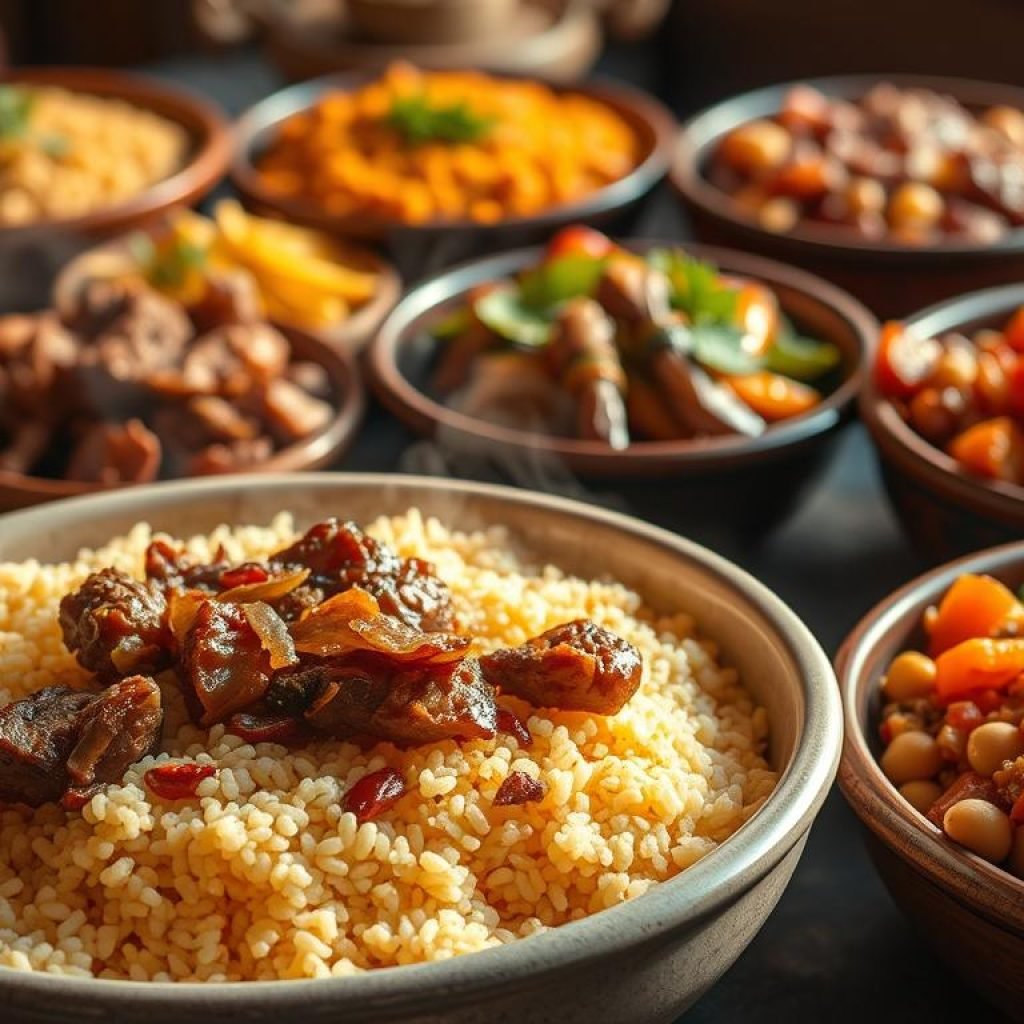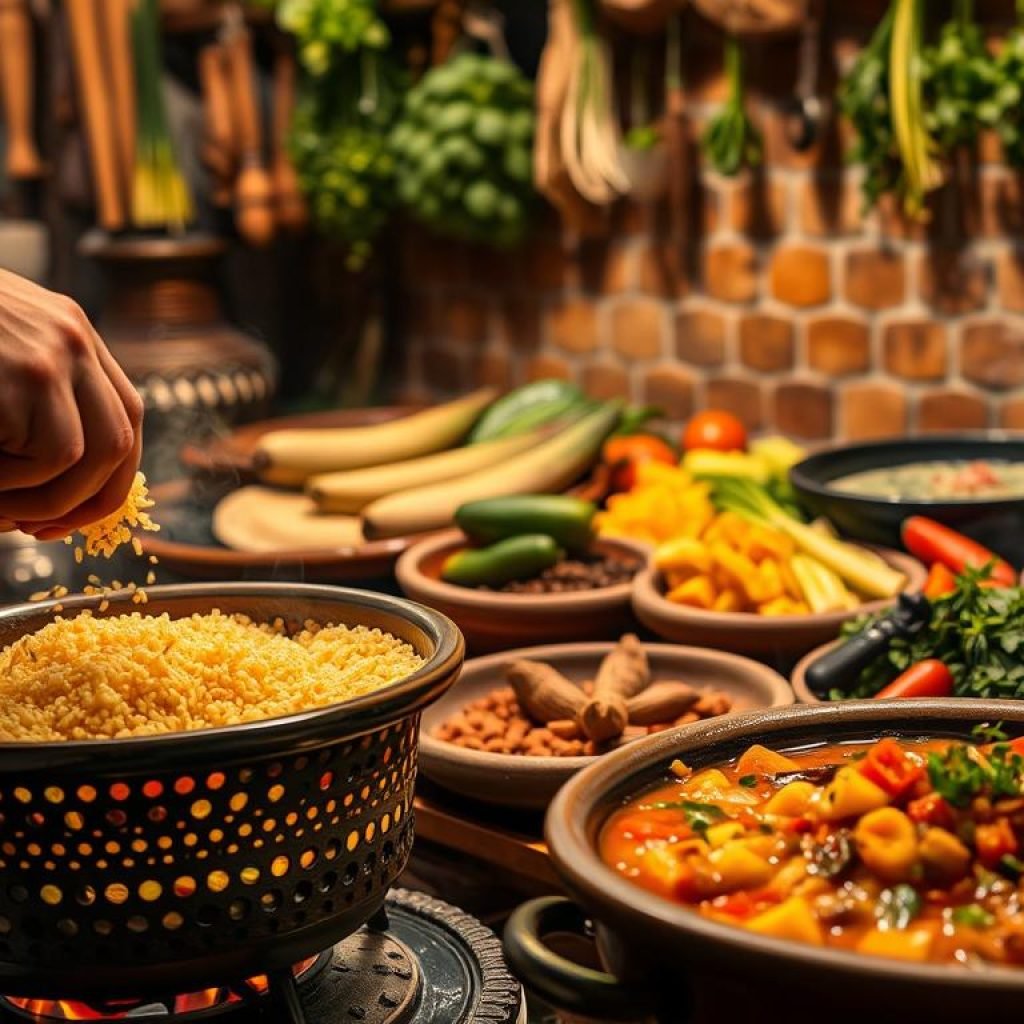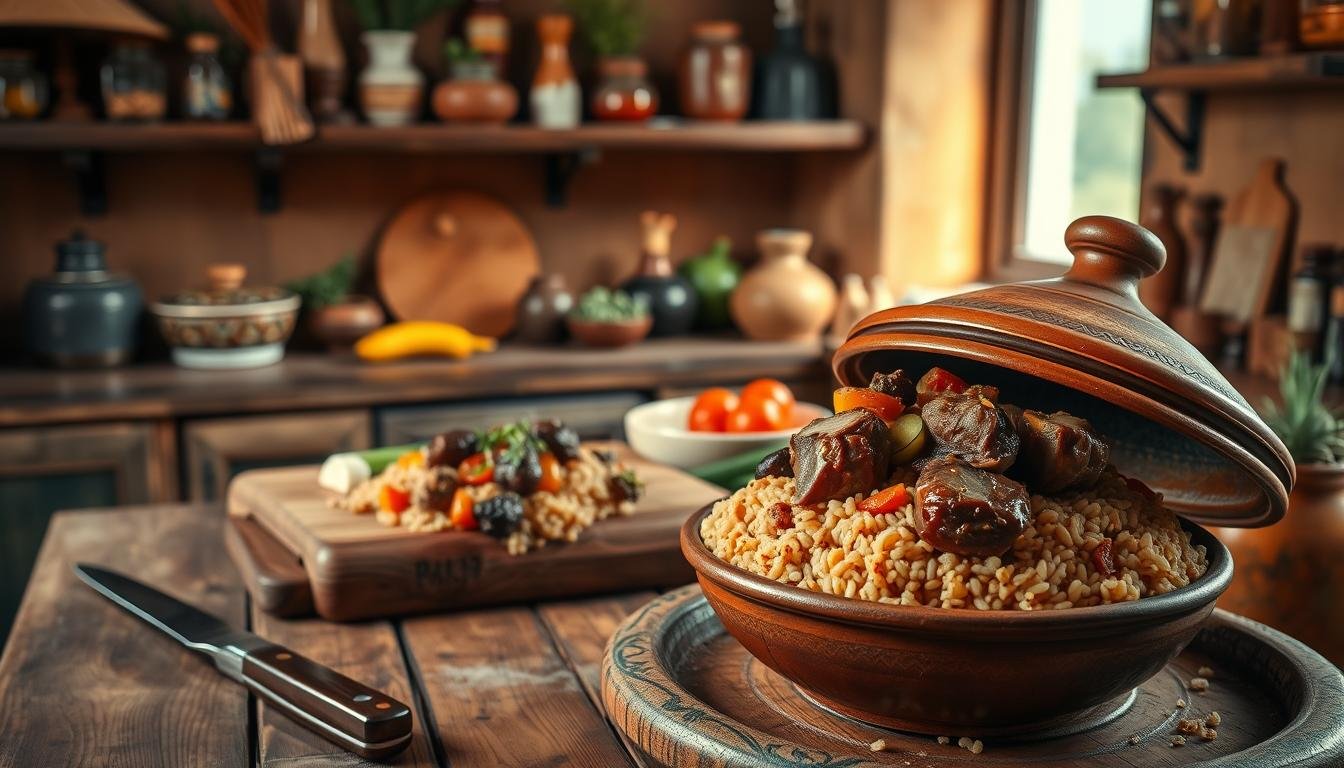What makes a traditional Moroccan tagine so special? How can you make its rich flavors and tender textures in your kitchen? We’ll explore the history of Moroccan couscous and traditional recipes.
As we dive into Moroccan cuisine, we’ll see how couscous history and recipes shape the country’s food identity.
Introduction to Moroccan Tagine
Moroccan tagine is a key dish that shows the country’s rich food heritage. It comes from North African cuisine, mainly the Maghreb region. Its evolution highlights the importance of couscous history and traditional recipes.
Key Takeaways
- Understanding the history and cultural significance of Moroccan couscous and traditional couscous recipes
- Exploring the unique characteristics of a traditional tagine pot and its role in slow cooking
- Learning about the essential ingredients and spices used in Moroccan tagine recipes, including the significance of Moroccan couscous history
- Discovering the various regional variations of tagine and their distinctive flavor profiles, highlighting traditional couscous recipes
- Mastering the art of cooking tender and flavorful tagine, with a focus on Moroccan couscous history and traditional couscous recipes
- Appreciating the importance of traditional couscous recipes in Moroccan cuisine and their cultural significance
- Exploring the rich history of Moroccan couscous and its evolution over time, and its impact on traditional couscous recipes
Introduction to Moroccan Tagine
North African cuisine is famous for its rich flavors and aromas. The tagine is a key dish, named after the earthenware pot it’s cooked in. It’s closely tied to couscous, a staple in Moroccan cooking.
The tagine pot traps steam, ensuring even cooking and tender meat. This makes the dish a favorite in North African cuisine.
Tagine’s history goes back to the late eighth century. It was used by nomadic tribes in North Africa for slow-cooking meat. Berber cuisine, with its focus on slow-cooked stews and spices, has greatly influenced tagine.
Some popular tagine recipes include:
- Lamb with dried prunes or apricots
- Chicken with preserved lemon and green olives
- Duck with dates and honey
These recipes show the diversity of North African cuisine. They highlight the role of tagine in its culinary tradition. Couscous, with its origins over 2000 years ago, is also tied to the Berber ethnic group.
Tagine and couscous are closely linked in Moroccan cuisine. They’re often served together. Couscous is steamed over a stew, blending flavors.
This combination reflects North Africa’s rich culinary heritage. Tagine and couscous are central to the region’s cultural identity.
Essential Ingredients for Tagine
Preparing a traditional Moroccan tagine requires careful ingredient selection. Moroccan culinary traditions highlight the importance of fresh, aromatic ingredients. These are key to a rich, flavorful dish. At the heart of every tagine recipe are the base ingredients, including 
Proteins like chicken, beef, or lamb are common in tagines. They’re slow-cooked with vegetables and spices in a tagine pot. This mix of historical couscous dishes and modern flavors creates a unique taste.
Some essential spices for tagine recipes are turmeric, cinnamon, saffron, ginger, and cumin. These spices add a special, aromatic flavor to the dish.
Here are some key ingredients for your tagine recipe:
- Protein: chicken, beef, or lamb
- Vegetables: onions, tomatoes, potatoes, carrots
- Spices: turmeric, cinnamon, saffron, ginger, cumin
- Base ingredients: couscous, bread
By mixing these ingredients and following Moroccan culinary traditions, you can make a delicious, authentic tagine. It’s perfect for impressing friends and family. Whether it’s for a small group or a big crowd, a tagine offers a flavorful, satisfying meal rich in historical couscous dishes and tradition.
Selecting the Right Tagine Pot
Choosing the right tagine pot is key for cooking traditional couscous recipes. You’ll find many options, from clay pots to modern ceramic and cast iron ones. It’s important to think about the material, size, and features of the pot.
A smaller tagine, 8 to 10 inches, is great for cooking for two. Larger ones, 12 inches or more, are perfect for family meals or parties. Even heat distribution is crucial for cooking couscous well.
Clay pots are often chosen for their heat distribution and flavor. But, modern ceramic or cast iron tagines also work well. Look at options like the Emile Henry Made In France Tagine or the Kamsah Hand Made and Hand Painted Tagine. Traditional couscous recipes can be adapted for use with a tagine pot.
Here are some tips for picking a tagine pot:
- Choose a size based on how many you’ll cook for.
- Think about the material and its heat distribution.
- Look for a conical lid to keep moisture in.
- Make sure it’s oven-safe for easy cooking.
It’s important to care for your tagine pot to avoid damage. Follow the manufacturer’s instructions. Season the pot, use a heat diffuser, and avoid sudden temperature changes. With the right pot and care, you can enjoy delicious couscous and tagine dishes for years.
Preparing Your Ingredients
To make authentic North African cuisine, like Berber dishes, you need to prepare ingredients carefully. This means knowing how to prepare meat, chop veggies, and mix spices. The quality of your ingredients will greatly affect the taste and texture of your dish.
Choosing the right meat for tagine is key. Use tougher cuts like lamb shoulder or beef shank for slow-cooking. Marinating the meat before cooking can make it taste better and become tender. In Berber cooking, marinating is common. It involves mixing spices, herbs, and sometimes yogurt or lemon juice for flavor.
Chopping veggies right is also important for texture and look. Use a sharp knife to cut onions, carrots, and zucchini into even pieces. This helps them cook evenly and makes your dish look good.
Here are some tips for mixing spices:
- Combine ground spices like cumin, coriander, and cinnamon for a warm, aromatic taste.
- Add a pinch of salt to enhance the flavors of other spices and ingredients.
- Feel free to try different spice blends to find the perfect mix for your dish.
By using these tips, you’ll be able to make tasty North African dishes. These dishes will show off the rich flavors and traditions of Berber cuisine.
Cooking Techniques for Tagine
To make the perfect tagine, you need to know the cooking techniques. This Moroccan dish takes patience and detail, simmering for hours. It comes from Berber culture, served with steamed veggies and broth. Today, the ratio of couscous to veggies is still 1:1.
Layering ingredients is key for great flavor. Meat and veggies go in a certain order to soak up the dish’s flavors. Cooking it low and slow is important. 
Using the right pot is crucial, like traditional clay braziers. High-quality spices and meats are also essential. Morocco’s tagine dishes mix different cultures’ flavors. By following these tips, you’ll make a delicious, authentic tagine that honors Morocco’s culinary heritage.
Popular Moroccan Tagine Recipes
Moroccan cuisine is rich and diverse, with tagine recipes leading the way. Tagine cooking has a long history, dating back to the 8th century. It has been shaped by cultures like Berber, Arab, and French. Traditional couscous recipes often pair with tagines, highlighting the Moroccan couscous history in the country’s food culture.
Popular tagine recipes include lamb with dried prunes or apricots, chicken with preserved lemon and green olives, and duck with dates and honey. These dishes blend spicy and sweet flavors, a key feature of Moroccan cuisine. Adding traditional couscous recipes to these tagines enhances their flavor and texture.
Tagine cooking relies heavily on aromatic spices like ginger, turmeric, cumin, and cinnamon. These spices, combined with nuts and dried fruit, create a rich flavor profile. Here are some well-loved tagine recipes:
- Lamb tagine with prunes and spices
- Chicken tagine with apricots and almonds
- Vegetarian tagine with chickpeas and preserved lemons
These recipes show the diversity and richness of Moroccan cuisine. They also highlight how traditional couscous recipes can enhance various tagine dishes. By exploring the Moroccan couscous history and traditional recipes, cooks can create their own unique versions.
Side Dishes to Serve with Tagine
North African cuisine, like Moroccan dishes, is enhanced by the right side dishes. Traditional Moroccan bread, such as Khobz, is a must. It pairs well with tagine, soaking up the flavorful sauces. Couscous, with its North African roots, is also a favorite. It’s often served with vegetables, meats, or on its own.
There are many side dishes that go well with tagine. Here are a few:
- Roasted vegetables, such as carrots, zucchini, and bell peppers
- Salads, like the Moroccan carrot salad or the tomato salad, which add a refreshing touch to the meal
- Grilled meats, such as lamb or chicken, which can be served alongside the tagine
These side dishes add variety and highlight North African cuisine’s diversity. Couscous, with its rich flavors and aromas, is a key part of this heritage. Serving these dishes with tagine makes for a delicious, well-rounded meal that will impress your guests.
Exploring North African cuisine? Start with these side dishes. They focus on fresh ingredients, bold spices, and hearty portions. They’re sure to become favorites in your kitchen, just like couscous is in North African cuisine.
Storing Leftover Tagine
Storing leftover tagine right is key to keeping it tasty and safe. Knowing how to store leftovers is as vital as cooking itself. For those keen on Moroccan food, visiting Morocco offers a rich look into dishes like tagine and couscous.
Historical couscous dishes have long been a favorite in Morocco, enjoyed at big events. Here are some tips to keep your leftover tagine fresh:
- Refrigerate leftovers in an airtight container within two hours of cooking.
- Label the container with the date and contents.
- Store in the refrigerator at a temperature of 40°F (4°C) or below.
Freezing is also a good choice for longer storage. Frozen tagine can last up to 4 months. When reheating, use low heat or microwave-safe bursts to avoid overheating.
Proper storage is the secret to enjoying your leftover tagine. By following these easy steps, you can keep your dish fresh and ready to eat anytime. It’s just like how traditional couscous preparation methods and historical couscous dishes are savored in Morocco.
Common FAQs About Tagine Cooking
People often wonder about the best ways to cook and reheat tagine. They also ask about its connection to couscous. Couscous has a long history, dating back to the 7th century A.D. It was brought to North Africa by Arab armies.
Many ask how to reheat tagine right. The answer is to use low heat and keep it covered. This helps keep the flavors and textures of the ingredients. It’s similar to how couscous is steamed to get the right consistency.
Some also wonder if you can cook tagine in an oven. While traditional cooking uses a clay pot, oven cooking is an option. Just make sure to adjust the cooking time and temperature to get the best results.
Exploring Moroccan cuisine is exciting. Learning about tagine cooking and couscous can be a great start. Whether reheating tagine or trying new recipes, diving into Moroccan traditions is rewarding. It’s a journey that highlights the rich flavors and history of Moroccan dishes.
Health Benefits of Tagine Ingredients
Traditional couscous recipes are a big part of North African cuisine. They are packed with nutrients. Ingredients like lean proteins, various vegetables, and spices bring many health benefits.
Some of the key health benefits of tagine ingredients include:
- High protein content: Couscous is made from durum wheat, which is known for its high protein content, making it an excellent option for those looking to increase their protein intake.
- Rich in fiber: Whole grain couscous is high in fiber, which can help reduce the risk of developing type 2 diabetes and promote feelings of fullness.
- Antioxidant and anti-inflammatory properties: The spices used in North African cuisine, such as cumin and coriander, have antioxidant and anti-inflammatory properties, which can help protect against chronic diseases.
Traditional couscous recipes are also low in fat and calories. This makes them perfect for those trying to manage their weight. With their rich nutritional value and health benefits, it’s clear why couscous is a favorite in North African cuisine.
Conclusion: Embracing Moroccan Cuisine
Our journey through Moroccan cuisine has shown us the richness of dishes like tagine and couscous. Understanding Moroccan couscous history helps us see its cultural value. Couscous preparation methods may differ, but the result is always a tasty meal.
Moroccan cuisine is known for its variety of couscous dishes. You can try Couscous Royale with its mix of meats and veggies, or vegetable couscous with its vibrant ingredients. Whether you’re interested in Moroccan couscous history or just want to learn how to make it, there’s plenty of information out there.
Some popular types of couscous include:
- Couscous Royale: a hearty dish with a variety of meats and vegetables
- Vegetable couscous: a colorful and flavorful option with a range of ingredients
- Fish couscous: a delicious and refreshing choice for seafood lovers
We encourage readers to dive into Moroccan cuisine and try cooking at home. The unique flavors and traditions of this country are sure to inspire and please. Moroccan cuisine, with its special spices, ingredients, and couscous preparation methods, will quickly become a favorite in any kitchen.
Additional Resources for Tagine Enthusiasts
If you love exploring Moroccan cuisine, there’s a lot to discover. You can find books, cookbooks, and online communities that go beyond cooking. They help you understand the history and flavors of tagine and couscous.
Recommended Books and Cookbooks
Learn about Moroccan tagine’s cultural and culinary roots with books like “The Tagine Deck” by Joyce Goldstein or “Mastering the Art of Moroccan Cooking” by Ghillie Basan. These books dive into the historical couscous dishes and Moroccan culinary traditions that make tagine special.
Online Communities and Forums
Join online groups like Moroccan Cuisine Community on Facebook or the Tagine Recipes subreddit. These places are great for sharing recipes, tips, and stories. They let you dive deep into Moroccan cooking culture.




Comment (0)